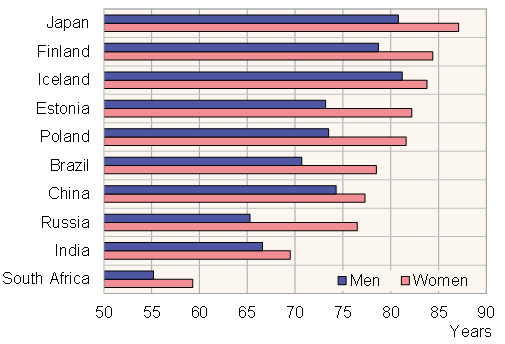BOFIT Weekly Review 27/2017
Life expectancies in Russia up sharply, but gap between men and women remains huge
Rosstat reports that the life expectancy of girls born in Russia last year rose to 77.1 years, while that for boys rose to 66.5 years. Life expectancies of Russians have increased notably from the late-1990s, when the life expectancy for men was still well below 60. Life expectancies have increased with improvements in healthcare resources and lifestyle changes. Cardiovascular disease, however, remains a major cause of death in Russia.
OECD countries and many middle-income countries boast longer life expectancies than Russian men. In addition, in Russia the difference in life expectancy is particularly pronounced between men and women. In 2015, Japanese women had the longest life expectancies for OECD countries – 87.1 years. Iceland boasted the longest expected lifespan for men – 81.1 years. Numerous countries poorer than Russia had higher life expectancies, highlighting the generally poor condition of Russia's national healthcare system. For example, the average expected lifespan in China was 77.3 years for women and 74.3 years for men. The life expectancies of men were also higher than in Russia in Brazil (70.7 years) and India (66.6 years).
The life expectancies especially for men in Russia are expected to rise further in coming years, tracking trends in most developed countries. Therefore, Rosstat's latest demographic forecast expects the number of pensioners to increase significantly. The middle variant of Rosstat's three forecast scenarios sees the number of working age people falling by the end of 2035 by slightly over 4 % to 78.7 million people. In the UN's latest demographic forecast, the number of Russians between the ages of 15 and 60 will decline slightly more between 2020 and 2035 (about 5 %). In Rosstat's forecast the labour force will be bolstered by net immigration adding 300,000 people a year to the workforce through 2035.
Life expectancies in selected countries in 2015

Sources: Rosstat and OECD.